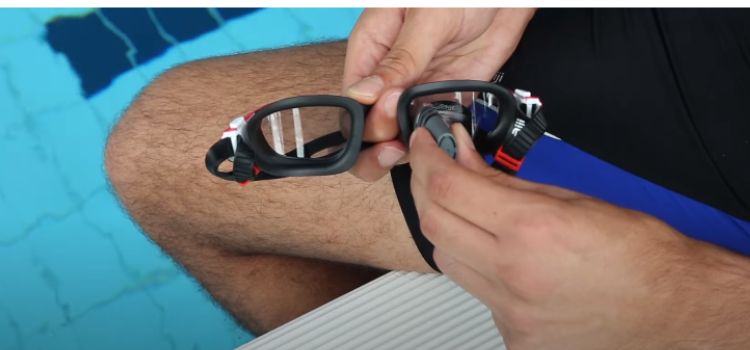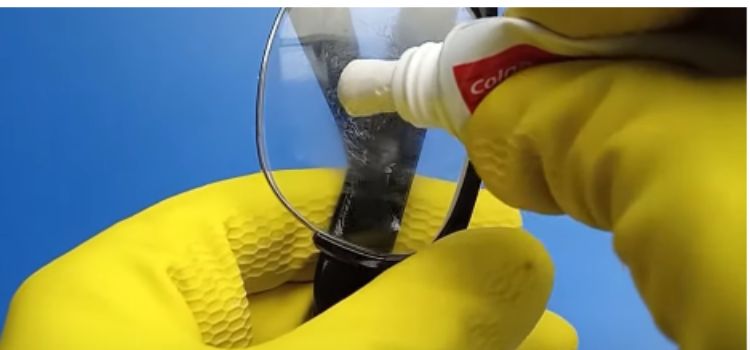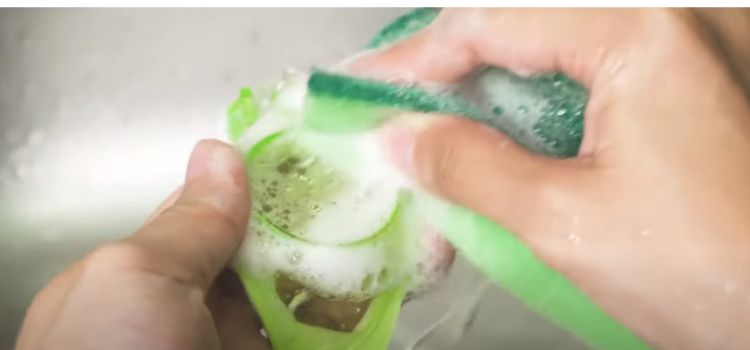As an Amazon Associate I earn from qualifying purchases.
Swimming goggles are a vital piece of gear whether you’re a competitive swimmer or just want to splash around in the water. By offering these advantages, they improve your swimming experience while assisting you with seeing well underwater and shielding your eyes from allergens and chlorine. Swim goggles can, however, get scratches over time, which can blur your vision and make swimming less enjoyable. Don’t give up if your swim goggles become scratched. To get rid of those scuffs and prolong the lifespan of your goggles, you can attempt a number of different techniques. Here we will discuss about How to Remove Scratches from Swim Goggles.

Preventing Future Scratches
Before we get started, it’s crucial to emphasize that prevention is always preferable to Remove Scratches from Swim Goggles. You may prevent scratches from happening in the first place by taking good care of your goggles. The following advice will help you keep your swim goggles free of scratches:
Rinse After Use: After each use, thoroughly rinse your swimming goggles in cold water. This lessens the likelihood of lens scratches by removing impurities like salt, chlorine, and other irritants.
Avoid Touching the Lenses: When adjusting your goggles or wiping water off the lenses, stay away from touching the lens surface. Your fingertips may get scratched up from the oils and debris.
Use a Goggle Case: Invest in a goggle case to keep your goggles safe when not in use. This protects them from getting scratched while in use or in your swim bag.
Utilize anti-fog and anti-scratch treatments: Some eyewear makers offer these coatings. These can assist keep your goggles clear and lessen the chance of scratches.
Replace Straps and Gaskets: Goggle straps and gaskets can deteriorate and become abrasive over time. Replace these components on a regular basis to keep your goggles functioning properly.
Some methods are given for removing Scratches from Swim Goggles
Now, if your swim goggles already have scratches, you can attempt the following techniques to get rid of them:
1. Toothpaste Method:

Unexpectedly, a typical household item, toothpaste, can be used to repair tiny dings on swimming goggles or Remove Scratches from Swim Goggles. How to do it is as follows:
Materials required:
- Freshwater
- Microfiber cloth
- Mild toothpaste (not gel or with abrasive particles)
Steps:
1. Start by cleaning your swim goggles thoroughly. To get rid of any dirt or debris, give them a fresh water rinse.
2. Apply a tiny amount of gentle toothpaste to the goggles’ scratched surfaces. To do this, use your finger or a cotton swab.
3. Gently press the toothpaste into the scrapes for two to three minutes in a circular motion. Avoid applying too much pressure since this can severely harm the lenses.
4. To fully remove the toothpaste, thoroughly rinse the goggles with fresh water.
5. Buff the goggles to a brilliant sheen after drying them with a microfiber cloth.
6. Check the eyewear to check if the scratches have lessened. If more work is required, keep going until you are happy with the outcome.
2. Baking Soda and Water Method:

Another common household ingredient that can be used to polish swim goggles is baking soda. This is how you do it:
Materials Needed:
- Baking soda
- Water
- Microfiber cloth
- Freshwater
Steps:
1. To make a thick yet spreadable paste, combine baking soda and water.
2. To get rid of any loose debris, wash the goggles with clean water.
3. Using a cotton swab or your fingers, apply the baking soda paste to the goggles’ scratched regions.
4. For around two to three minutes, gently work the paste in a circular manner into the scratches.
5. Rinse the goggles thoroughly in fresh water to get rid of all of the paste.
6. After the goggles are dried, polish them to a brilliant shine using a microfiber cloth.
7. Check the goggles to check if the scratches have lessened. If more work is required, keep going until you are happy with the outcome.
3. Use a Scratch Repair Kit:
On the market, there are specialized scratch-repair products made specifically for spectacles and goggles. These kits frequently come with different buffing pads and polishing paste. They may be more expensive than commonplace products like toothpaste or baking soda, but they are designed specifically to remove scratches from lenses. How to use a scratch repair kit is as follows:
Materials Needed:
- Scratch repair kit
- Freshwater
Steps:
1. Comply with the directions on the scratch repair kit. Each kit might include unique instructions for the best outcomes.
2. Before beginning the repair process, thoroughly rinse the goggles with clean water to remove any loose debris.
3. Polish the goggles’ scratched parts using the polishing agent that is advised.
4. Gently work the compound into the scratches in a circular motion using the buffing pads that are included. Make careful to adhere to the advised pressure and time recommendations.
5. Rinse the eyewear with clean water to get rid of any leftovers.
6. Buff the goggles to a brilliant sheen after drying them with a fresh microfiber towel.
7. Check the goggles to determine if the abrasions have lessened. If more work is required, keep going until you are happy with the outcome.
4. Use a Glass Etching Cream:
A more forceful technique for eliminating scratches is glass etching cream. It is not advised for all varieties of swim goggles and should be used with caution. Before using this technique, make sure your goggles have plastic or polycarbonate lenses because it could not work with them. Read and abide by the safety instructions printed on the glass etching cream container at all times. This is how to apply it:
Materials Needed:
- Glass etching cream
- Rubber gloves
- Safety goggles
- Freshwater
- Microfiber cloth
Steps:
1. Protect your hands and eyes by using rubber gloves and safety eyewear.
2. To get rid of any loose debris, wash the goggles with fresh water.
3. Use of tiny amount of glass etching cream to the scratched parts of the goggles . To achieve this, use a tiny brush or a cotton swab.
4. Gently massage the cream into the scratches for a little amount of time, usually less than a minute. Avoid going overboard since glass etching cream can quickly erase material.
5. Thoroughly rinse the eyewear with fresh water to get rid of all of the cream.
6. Buff the eyewear to a clear shine after drying it with a fresh microfiber towel.
7. Check the goggles to determine if the abrasions have lessened.
5. Professional Repair or Replacement:
Consider professional repair or replacement options if the scratches on your swim goggles are severe or widespread and the DIY remedies don’t work well:
• Professional Repair: Some eyewear retailers and opticians provide lens repair services. They can fix scratches on eyeglasses and goggles thanks to their specific tools and knowledge. Although it may cost extra, this service is frequently a trustworthy choice.
• Replacement: If you will not be able to fix your goggles, it’s time to think about getting new ones. You will have clean, scratch-free lenses for your upcoming swim if you do this, which is pricey.
Tips and Warnings:
- Whenever attempting to remove scratches, whether with common home items or specialized kits, always exercise gentleness. Excessive pressure can further harm the lenses.
- To make sure a technique has no negative side effects, test it first on a tiny, discrete area of the eyewear.
- If you have swim goggles with a prescription, go to your eye doctor before attempting any do-it-yourself scratch removal techniques because they might change the prescription.
- No need to use sandpaper or steel wool to remove scratches because they can harm the lenses.
- Make sure your goggles are clean and clear of any residues that can impair your vision after removing scratches.
- Check your swim goggles on a regular basis for symptoms of wear and tear. It’s best to handle small concerns before they develop into larger ones.
Conclusion
Swim goggles are a priceless piece of gear for swimmers, and maintaining them in good shape is crucial for a pleasurable swimming experience. Even while prevention is the best strategy, you now have a number of options to test out if your goggles start to get scratches. There are solutions to meet your needs and budget, ranging from commonplace materials like toothpaste and baking soda to specialized scratch repair kits and even glass etching cream (with caution). To get the greatest results, always be careful and utilize the right technique for the material of your goggles’ lenses. If everything else fails, professional repair or replacement is a workable option to maintain your eyes’ protection and underwater vision.
FAQs
Yes, scratches can distort your vision and be a safety hazard. It’s crucial to address them promptly.
Toothpaste is safe for most lenses, but it’s essential to check the manufacturer’s guidelines to ensure compatibility.
Vinegar is not recommended, as it can damage the anti-fog and UV coatings on the lenses.
Replace your lenses when scratches become too deep or numerous, affecting your vision.
Yes, always rinse your goggles with fresh water after swimming, store them in a protective case, and avoid touching the lenses.
If DIY methods fail, consult an optician for professional advice.
Amazon and the Amazon logo are trademarks of Amazon.com, Inc, or its affiliates.
Leave a Reply